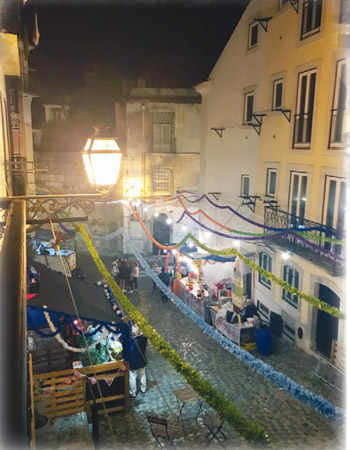By Marek Kulig

Photos courtesy of Marek Kulig
“I’ll come back a Port wine expert,” I predicted proudly to nobody in particular prior to leaving for Lisbon last June. Though I had never been to Portugal’s capital city, I pulled such an expectation—that Port wine comes from Portugal, is in and of itself traditionally Portuguese, and is, therefore, the drink of choice—out of what I thought was the popular notion. Port—Portugal.
On the night I arrived in Lisbon, my first drink was a Sagres, one of the city’s two ubiquitous beers (Super Bock being the other). Then I had another. And another. Then, from a chocolate mold, a shot of Ginjinha. Or was it two? Made from sour cherries soaked in a spirit called aguardente, Ginjinha is a tad nearer Port than beer, but still, no cigar. I was indulging in these Portuguese delicacies in one of Lisbon’s oldest districts, the windy-streeted, charmingly crumbly Alfama, and the Sardine Festival had just begun.
Honoring Saint Anthony of Padua, locals had decorated the narrow alleys with colorful streamers and holiday lights, and alongside family and tourists, were paying homage under a canopy of celebration. Live popular rock blared from speakers mounted to surrounding buildings. Joining random conga lines breaking out like sparklers on the Fourth of July seemed apropos, as was going to bed when the sun yawned above the hills just beyond the Tagus River.
Starting the next day, a beer became customary on many occasions throughout the week—accompanying a marinated pork cutlet on white bread rolls for lunch; over an afternoon conversation, untainted by phone-checking; and because it’s perfectly acceptable in Lisbon, on long walks from one hilly district to another.
Occasionally, a Porto tonic served as an equal but dissimilar refreshment. And maybe this half Port, half tonic tipple could ease me into purer, more comprehensive Port drinking, one involving tasting flights, palate refining, and pairings.
At happy hour, a Caipirinha to start— briefly: into a rocks glass add 2 teaspoons of sugar and 1 lime cut into wedges, muddle, top with crushed ice and 2 to 3 ounces Cachaca (pronounced ka-sha-suh). Depending on who you ask, it can be muddled, and then shaken and strained into a highball glass. Every bartender claims, too, that their Caipirinha is the best around.
Vinho Verde, the pan-entree wine, with most dinners. Or just another beer, really. For dessert? Caipirinha, please!
To be clear, though, this Port abstinence doesn’t suggest that it wasn’t available any day at any time, or that I was consciously shunning Port after experiencing the Zen of all the other beverages I was imbibing. Much like Lisbon itself, Port allowed me to enjoy it within my own rhythm.
The following weekend, another festival had begun, and I imagine somewhere amidst the traditional revelry, a Port wine was savored. But developing expertise on the historic and complex fortified wine from Portugal no longer occupied the forefront of my mind. Port was just another libation to enjoy liberally.
If there is a lesson to be learned here, it’s not one of lessening expectations, or even letting what happens on one trip mold those of future travels. Maybe it’s something more complimentary, like: Celebration is the sincerest form of tradition.
I came back from Lisbon, where the tradition is to celebrate, without a bottle of Port.
Marek Kulig is a writer from Dartmouth, MA, which is next to New Bedford, MA, where on July 30–August 2, 2020 the 106th Annual Feast of the Blessed Sacrament will be held. If you really want to celebrate, you’ll do the research. Até mais então!






